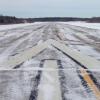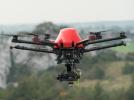AS Avies JS31 at Pajala on Feb 13th 2013, touched down with nose and right main gear off runway
An AS Avies British Aerospace Jetstream 31, registration ES-PJB performing flight U3-2094 from Lulea to Pajala (Sweden) with 13 passengers and 2 crew, landed on Pajala's runway 11 in darkness however touched down with the right hand main gear and nose gear out of the runway. The aircraft was steered back onto the runway and rolled out without further incident, no injuries and no damage occurred.
Sweden's Statens Haverikommission (SHK) released their final report concluding the probable cause of the incident was:
The incident was caused by deficient directional control during the final stage of the landing, probably with perceptual illusions from drifting snow and dazzling by high-intensity lights as contributing causes.
The SHK complained that the incident was not reported to them until 50 days later, when the airport notified the commission. The SHK reported, that the captain of the flight had contacted ground staff immediately after landing and had gone to the runway to check, there was no damage to the runway lightings but it was clear the aircraft had touched down outside the runway. The captain subsequently checked the aircraft for damage but did not find any. Subsequently he phoned the airline's dispatch and informed them about the incident, however, obviously without reporting the touchdown had occurred outside the runway edge. The airline did not file a written report.
The SHK reported that the aircraft landed in darkness, the runway lighting was operative however at a maximum of 10% of brightness. The landing occurred in blowing snow and limited visibility.
According to testimonies by both flight crew the aircraft had performed a normal stabilized approach. During flare, after reducing engine thrust to idle, the aircraft drifted to the right and landed close to the runway edge according to their perceiption.
The SHK reported that the runway edge lights were mounted 2.8 meters outside the paved runway surface, the right hand main gear just missed the right hand runway edge lights, the nose gear was just off the paved surface of the runway.
The SHK analysed that the approach was not difficult, there were light winds, 500 feet cloud base, good visibility, the crew was familiar with the airport, it was not likely the crew was under high workload. There had been no technical malfunction or other technical deviation that could have influenced the sequence of events.
Runway 11 does not feature runway center line lights, the painted runway edge line was not visible due to snow. The SHK stated: "These conditions probably contributed to the pilots realising too late that the aircraft at touchdown was situated far out to the right of the runway's centre line."
The SHK analysed that the pilots reported being dazzled by the runway light intensity and stated: "SHK has been unable to clarify the reasons why the pilots did not request the lights to be dimmed."
The SHK stated: "It is well known that it is possible to perceive a relative movement that is different to the case in reality, such as a passenger perceiving that the train is moving, when in fact it is the neighbouring train that is moving. Similarly, a false impression of lateral movement can be given when travelling in a car at night in the winter and the snow is sweeping across the road in the headlights. Correspondingly, in winter, snow may be sweeping across an airfield giving a false impression of relative movement, which in turn can give rise to inappropriate flight control movements18. SHK has not been able to find any information in the operator's manual (OM A19) regarding guidance or risk factors for operations under conditions of blowing snow on snow-covered runways."
The SHK analysed: "However, what has emerged during the investigation is that additional factors may have had an effect on the sequence of events. The fact that the runway was covered in snow and did not have centre line lighting may, together with drifting snow, have produced a perceptual illusion that resulted in the aircraft drifting off towards the right side without the pilots noticing this."
The SHK continued: "In the present case, the fact that the aircraft “missed” all the runway edge lights during the approximately 200-metre long passage outside the runway can probably be attributed to fortunate circumstances."
Ground tracks (Graphics: SHK):
http://avherald.com/h?article=471d7338














Komentarze